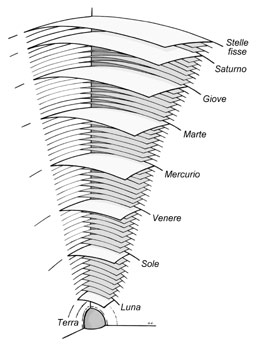

|
The crystalline celestial spheres
Mathematician Eudoxus of Cnidus (IV century B.C.) conceived of a series of geometric models to explain the complex motions of the planets with respect to the Earth, considered immobile at the centre of the Universe. Each model employed three or four spheres concentric to the Earth, and uniformly revolving one inside the other. Callippus of Cyzicus (IV century B.C.) made these models more faithful to the phenomena observed, increasing the number of spheres up to four or five per planet.
The models of Eudoxus and Callippus were probably mere geometric constructions. And yet, when he laid out the physical architecture of the Cosmos, the philosopher Aristotle (384-322 B.C.) decided to join these models into a single celestial machine. Movement was propagated by contiguity and progressively decreased from the outer regions of the World towards the inner regions. It began in the highest and fastest of the stars, and was passed in order to the spheres of Saturn, Jupiter, Mars, Mercury, Venus and the Sun, finally reaching the lowest and slowest sphere, the Moon. In order to connect the models of Eudoxus and Callippus, Aristotle introduced a consistent number of additional spheres, up a total of 55 (Metaphysics , XII, 8). All of the celestial spheres were formed of crystalline matter, innate, eternal, incorruptible, imponderable and perfectly transparent (De Caelo , II, 1) - ether or quintessence - quite different from the other four elements that made up the heavy and corruptible sub-lunar world: earth, water, air and fire.
|
 previous |
next
previous |
next 
|